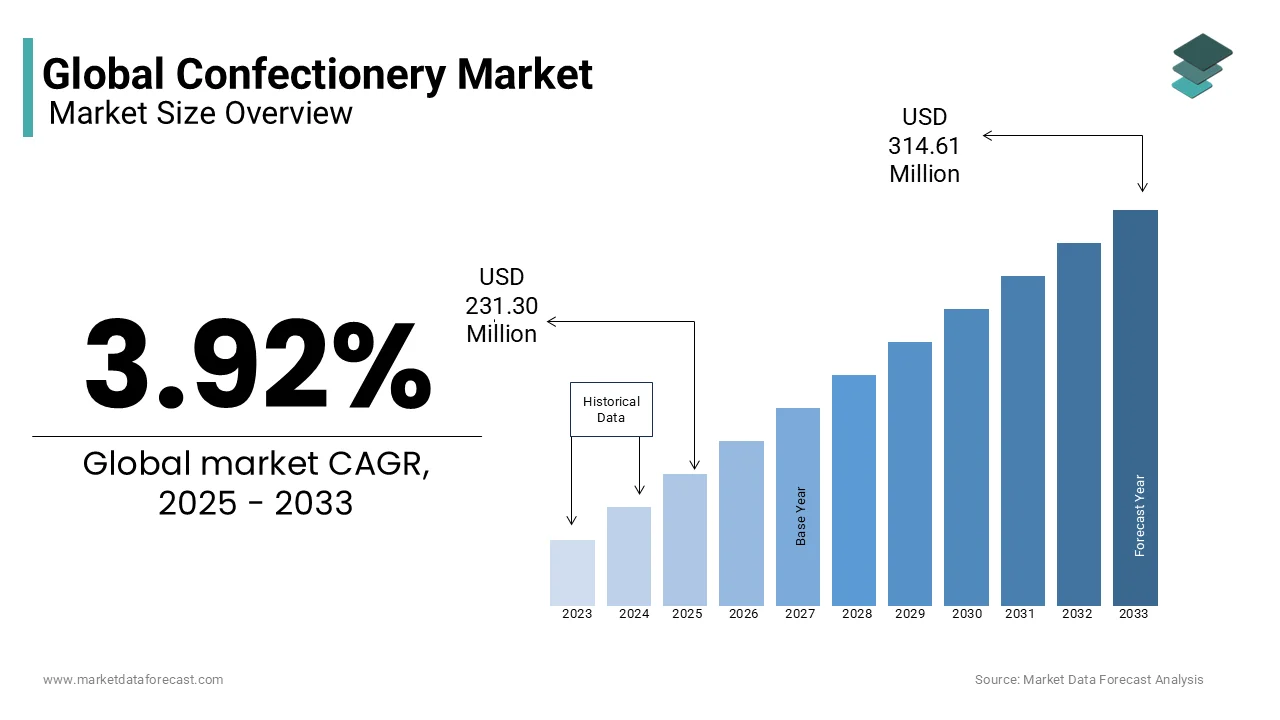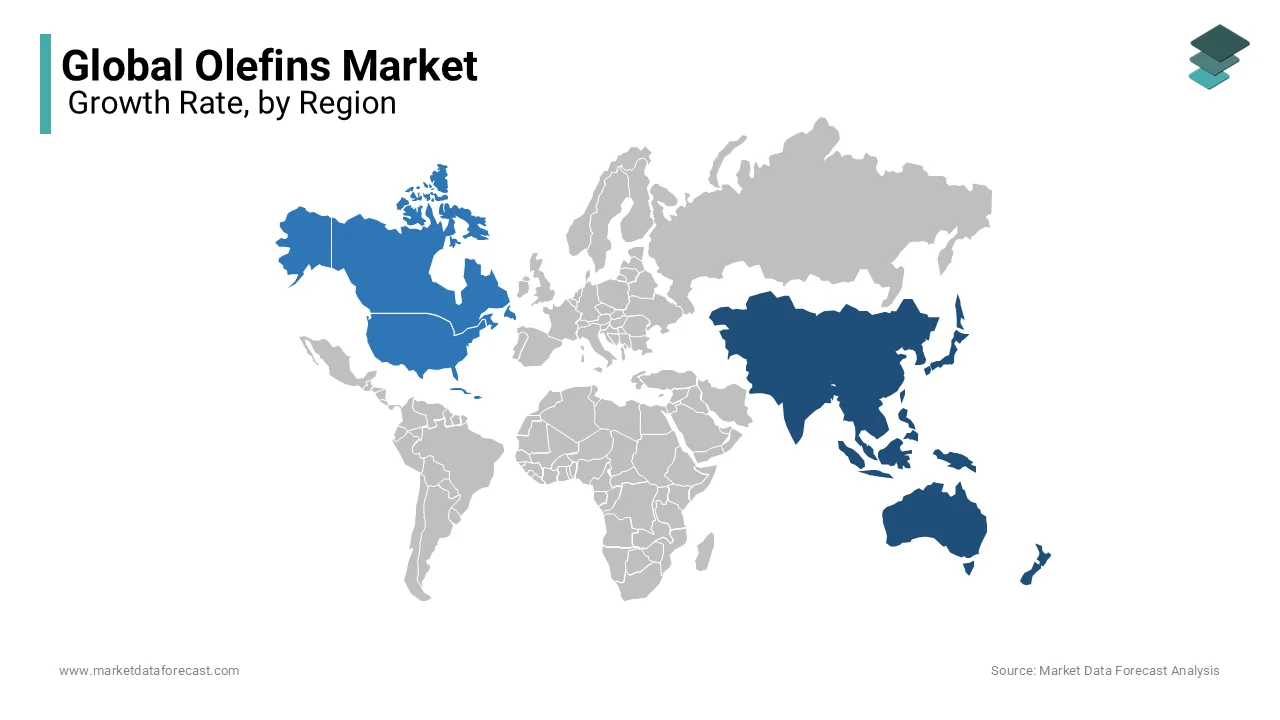Global Confectionery Market Size, Share, Trends & Growth Forecast Report - Segmented By Type (Gums, Sugar, and Chocolate), Distribution Channel, and Region (North America, Europe, Asia Pacific, Latin America, Middle East and Africa, And Rest of the world) – Industry Analysis 2025 to 2033
Global Confectionery Market Size
The global Confectionery market size was calculated to be USD 222.58 million in 2024 and is anticipated to be worth USD 314.61 million by 2033 from USD 231.30 million in 2025, growing at a CAGR of 3.92% during the forecast period

MARKET DRIVERS
The increasing modernization and the hectic combination of professional and personal obligations are some of the main factors that trigger the demand for practical snacks as part of the daily diet. The busy lives of consumers do not allow them to spend time cooking and dining outside during work hours, leading them to search for food products that are easy and quick to eat. The number of consumers in the workplace is increasing today and it is increasingly difficult to maintain a healthy balance between work and personal life. Therefore, manufacturers and merchants are capitalizing heavily on introducing and promoting a variety of chocolate snacks, such as take-out snacks, chocolate bars, and the like to provide consumers with healthy food. They also focus on practical, small packaging offerings that allow consumers to carry candy and bars in their bags. Chocolate is one of the most consumed products worldwide and is associated with many health benefits. For example, it is a rich source of antioxidants that improves insulin sensitivity and lowers blood pressure. Therefore, a growing association of chocolates with youth and other working populations around the world is expected to drive the confectionery market growth during the forecast period.
MARKET RESTRAINTS
Improvements in the lifestyles of consumers around the world are also undergoing a radical change, particularly in their diet and daily health. As a result of these changes, various lifestyle-related diseases have developed, such as diabetes, blood pressure, and others. Obesity, overweight, and the diseases associated with them are becoming serious concerns among consumers, posing major challenges to the sustainability of health systems worldwide. Consumers are increasingly shifting their preferences to low-calorie, sugar-free food products to eliminate these diseases. Growing health concerns have led to a reduction in sugar consumption among consumers. As a result, the demand for sugar-free chocolates is increasing and should continue to grow in the coming years. Demand for healthier snacks, as well as taste and sensory benefits among consumers, is increasing, which has led to the popularity of organic snacks and confectionery products worldwide. Consumers are increasingly interested in organic products, which opens up many opportunities in the confectionery Industry. The organic chocolate segment is experiencing decent growth in the global market and is gaining popularity with consumers. Manufacturers' reinforced efforts to meet the market demand for organic chocolate are ensuring the growth of the world market in the near future.
Cocoa and sugar are important raw materials that are mainly used for the production of confectionery products worldwide. The price of sugar and cocoa has fluctuated in recent years, as its production and demand vary rapidly on the world market. Cocoa and sugar yields are affected due to adverse weather conditions, crop diseases, labor availability, stock indexes, and other economic factors that hinder demand and its offer in the market. Consequently, the average annual price of raw materials varies from low to high and results in a surplus or a sub-reserve for the production of confectionery products on the market. Consequently, fluctuations in raw material prices are expected to decrease the entire market in the coming years.
REPORT COVERAGE
|
REPORT METRIC |
DETAILS |
|
Market Size Available |
2024 to 2033 |
|
Base Year |
2024 |
|
Forecast Period |
2025 to 2033 |
|
CAGR |
3.92% |
|
Segments Covered |
By Type, Distribution Channel And Region |
|
Various Analyses Covered |
Global, Regional and Country Level Analysis; Segment-Level Analysis; DROC; PESTLE Analysis; Porter’s Five Forces Analysis; Competitive Landscape; Analyst Overview of Investment Opportunities |
|
Regions Covered |
North America, Europe, APAC, Latin America, Middle East & Africa |
|
Market Leaders Profiled |
Brookside Foods, The Hershey Company, Crown Confectionery, Yildiz Holding, Petra Foods, Kegg's Candies, Perfetti Van Melle, United Confectionery Manufacturers, HARIBO Dunhills PLC, Cadbury, Ferrero Group, Kraft Foods, Parle Products Pvt. |
SEGMENTAL ANALYSIS
By Type Insights
The chocolate candy segment is the leading segment worldwide and has immense growth potential in developing economies. The increase in disposable income and the constant growth of developing economies are some of the main factors that drive the demand for various chocolates on the world market.

By Distribution Channel Insights
Supermarkets/hypermarkets are receiving great responses from consumers around the world. The increasing consumer dependence on these facilities, the freedom of selection, the widest range of products, and the group offerings offered by supermarkets have led to an increase in the number of feet on the ground. Consumers prefer to buy groceries in bulk over a given period due to their busy and busy schedules. Therefore, supermarkets/hypermarkets offer a convenient shopping experience to consumers under one roof.
Separate sections in supermarkets/hypermarkets provide an easy way for consumers to purchase chocolates and other confectionery. The rapid emergence of these points of sale worldwide should contribute significantly to generating income from confectionery products on the market. However, manufacturers are also focusing on small packages for middle-class consumers around the world, promoting the sale of candy in convenience stores, online stores, and department stores.
REGIONAL ANALYSIS
The Asia Pacific is one of the fastest-growing regions and is emerging with immense potential for chocolate products worldwide.The United States is one of the main markets where consumers are willing to spend on homemade confectionery products that improve the appearance of the products and increase their palatability.
 The
The
European confectionery market is slightly saturated but has the highest value sales among the other regions. Confectionery is the most popular type of snack in some European countries, including the United Kingdom, Germany, and Austria. These countries should consume 5 times the world average. Rapid urbanization, increasing disposable income, a young and dynamic population, and the easy availability of confectionery Market Share in consumer packaging are the main reasons for the growth of the regional market. Manufacturers are taking advantage of these opportunities by fully capitalizing on plant expansions and mergers and acquisitions with regional players. The increasing popularity, acceptance, and technological advancement of these products for consumers should be the important factors driving growth in the general market during the forecast period. On the other hand, slow growth is observed throughout the forecast period in South America, due to factors such as poor economic conditions, consumer health problems, and certain legislative challenges.
KEY MARKET PLAYERS
Key players in the Global Confectionery Market are Brookside Foods, The Hershey Company, Crown Confectionery, Yildiz Holding, Petra Foods, Kegg's Candies, Perfetti Van Melle, United Confectionery Manufacturers, HARIBO Dunhills PLC, Cadbury, Ferrero Group, Kraft Foods, Parle Products Pvt.
RECENT HAPPENINGS IN THE MARKET
-
the Barry Callebaut group opened the first Chocolate Academy center in Johannesburg, South Africa, to meet the growing demand for chocolate confectionery products and understand the needs of the country's consumers.
- CPC introduced three novel chocolate products in the marketplace. Products include Goldentree Premium chocolate, Goldentree Heritage artisan chocolate, and Goldentree Nuttychoc to meet the growing demand for premium chocolates on the world market.
MARKET SEGMENTATION
This research report on the Global Confectionary Market has been segmented and sub-segmented based on type, distribution channel, & region.
By Type
- Gums
- Sugar
- Chocolate
By Distribution Channel
- Online Retails
- Departmental Stores
- Convenience Stores
- Hypermarket/Supermarket
By Region
- North America
- Asia Pacific
- Europe
- Latin America
- Middle East and Africa
Frequently Asked Questions
1.What is the confectionery market?
The confectionery market refers to the industry involved in the production, distribution, and sale of sweets, candies, chocolates, chewing gums, and other sugary treats.
2.What are some popular products in the confectionery market?
Popular products in the confectionery market include chocolate bars, gummies, hard candies, lollipops, toffees, caramel candies, jelly beans, marshmallows, and various types of chewing gums.
3.What are the key factors driving the growth of the confectionery market?
Factors driving the growth of the confectionery market include changing consumer preferences, increasing disposable income, innovative product launches, expansion into new markets, and growing demand for indulgent treats and premium confectionery items.
Related Reports
Access the study in MULTIPLE FORMATS
Purchase options starting from $ 2500
Didn’t find what you’re looking for?
TALK TO OUR ANALYST TEAM
Need something within your budget?
NO WORRIES! WE GOT YOU COVERED!
Call us on: +1 888 702 9696 (U.S Toll Free)
Write to us: [email protected]